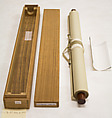“Lodge in the Bamboo Grove,” a Poem by Wang Wei
Nakamura Fusetsu 中村不折 Japanese
Not on view
A quatrain of verse in five-character lines by the celebrated Tang-dynasty poet Wang Wei (699–759) was exuberantly brushed, character by character, in two columns of semi-cursive script. The text can be transcribed and translated as follows:
独坐幽篁裏
弾琴復長嘯
深林人不知
明月来相照
Japanese pronunciation:
独り坐す幽篁の裏
弾琴復た長嘯
深林人知らず
明月来たつて相照らす
I sit alone
in a secluded bamboo grove,
Plucking the zither
and intoning poems.
No one knows
I dwell deep in the forest.
Only the brilliant moon
comes to join me when it shines.
(Translated by Tim Zhang)
The poem, with its imagery of a man of refinement living in reclusion made it popular as expression of Zen aesthetic priorities in Japan. In the second line the term changxiao 長嘯 (chōshō in Japanese) originally referred to a form of “transcendental whistling,” an ancient Daoist technique of creating a resounding whistling that served as a qigong or transcendental exercise that could be used to summon animals, communicate with supernatural beings, and control the weather. In Japan, the phrase also came to be used to refer to composing and reciting poetry.
The structure of the characters in this calligraphic composition follows the style of semi-cursive and cursive scripts by the Jin-dynasty masters of third- and fourth-century China, but each character was carefully structured and not elided with others; each stroke was rendered with its own individuality. The calligrapher constantly rolled the brush tip while completing each stroke, creating tremulous lines. Nakamura added further visual energy to his writing by introducing passages in each character where traces of the underlying ground show through. He achieved this effect by pressing down on the tip of the brush while letting the outer hairs remain dry, creates continuous dark passages within each stroke alongside drier raspy passages. This effect is evident, for instance, in the character for “moon,” tsuki 月, the fourth character from the bottom of the second column. Even though the ink textures vary within each character, the ink tone overall remains consistent throughout the composition, showcasing the calligrapher's control of his medium. The serene but strong rhythmic structure of the brushwork resonates with Wang Wei's image of a reclusive zither player.
Nakamura Fusetsu was one of the most celebrated calligraphers—and oil painters—of prewar Japan. He had traditional training in Chinese-style calligraphy and literati painting from his youth, and then later studied oil painting with Raphaël Collin (1850–1916) and Jean-Paul Laurens (1838–1921), both exponents of academic painting in Paris. Fusetsu was also a devoted collector of Chinese calligraphy and drew inspiration from it in his own work. He established the Shodō Hakubutsukan (Museum of Calligraphy, now part of the Taitō City Calligraphy Museum), which houses and holds regular exhibitions of his works and those from his extensive collection.
Due to rights restrictions, this image cannot be enlarged, viewed at full screen, or downloaded.
This artwork is meant to be viewed from right to left. Scroll left to view more.






